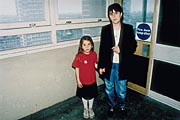|
FOREWORD
When I first viewed Howard Roberts’ group portraits of residents living in Seaton Pt I thought immediately of John Major’s remarks when he came to visit Hackney back in April of last year. Major’s depiction of council housing as “grey, sullen concrete wastelands, set apart from the rest of the community, robbing people of ambition, of self respect” is of course a fashionable one. There are many people who want to portray council housing as both a disaster and as an indictment of Britain’s post war housing policies. The truth is that for most of these critics there attitude is based, not on individual experience but derived from deep rooted prejudice or ignorance. While it goes without saying that residents living on estates such as Nightgale have had to contend with conditions that no one should be expected to tolerate, it is important we remind ourselves that for many millions of people council housing provides a security of tenure not available elsewhere.
For everyone who visits this exhibition these photographs will elicit their own particular meaning and significance. For me, as well as excellent portraits they provide a direct and powerful rebuke to the views advantaged by segments of the media and many of today’s politicians. They also offer an alternative and an altogether more honest vision to the view expound by the Prime Minster. In these photographs we are spared the patronising images such as abandoned and burnt out cars, or stray dogs wading though rubbish and litter. Instead we are offered an unfeigned context and an optimistic interpretation. Together these pictures depict a categorical truth – what everyone who has ever lived in council housing knows – that tenants on estates are not and never have been passive victims incapacitated by the environment in which they live.
In addition, the photographs, especially the ones taken inside people’s flats, give us a view denied to us in the usual council estate representations. The pictures undermine the notion that to live in a tower block impedes social interaction. They offer us a perspective and a setting in which individuals create and sustain relations both with others and their surroundings. In this respect, they are a testimony to the benefits that are derived from dialogue and friendship.
Finally, I believe Howard Roberts’ pictures can be construed as a timely reminder, to those involved in the efforts to revitalise council housing, that the estate’s future can never be allowed to be analytically separated from the aspirations of the residents themselves. However good new architectural designs may be or how effective housing management practices are, the future success of any redevelopment will ultimately depend on the council’s ability to engage with individual tenants such as these.
Keith Jacobs
University of Westminster
June 1996
|






















